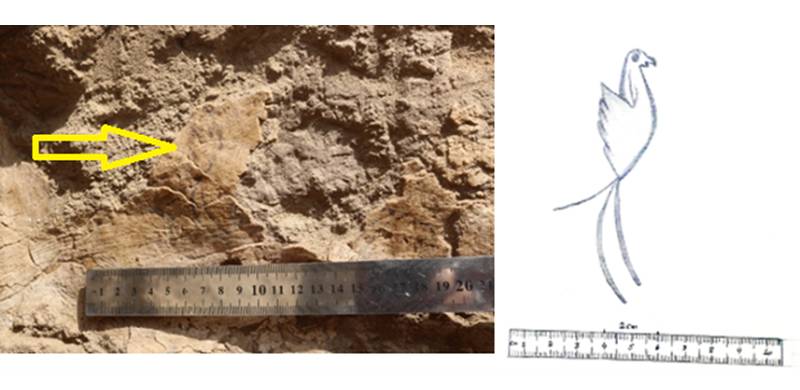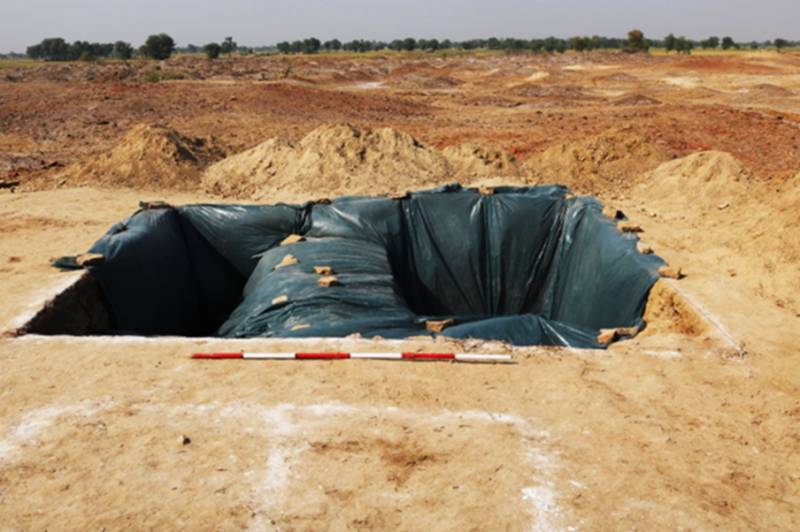Archaeologists have made stunning discoveries in the last few years in Pakistan. Of which the single-most-important find is the ancient mural paintings of birds at the archaeological site of Vijnot in Sindh. It is a rare contribution to the archaeological record of the Sindh province of Pakistan. These murals of birds are unusual finds indeed, as they are only of the type and age so far found in the archaeological landscape of the region. What is most interesting is that this discovery was made by young local archaeologists from the Shah Abdul Latif University and the Quaid-i-Azam University, and all of them were students at the time of the discovery. They deserve special mention here in recognition of their trowel-work: Rashid Ali Abbasi; Rukhsar Abro; Waqar Chang; Muddasir Khoso; Farman Jatoe; Nazar Abbas; Noor Illahi; Ghulam Murtaza Wassan, Sajjad Wagan; and Ghulam Hyder.
I learned about the Vijnot excavation through the in-charge of the excavation Mr Rashid Ali Abbasi, who is nowadays teaching archaeology at the Aror University of Art, Architecture, Design, Heritage and Culture, when they were still digging. Recently, the report of their reconnaissance titled “The Recent Excavation at the Ancient City of Vijnote, District Ghotki Sindh, Pakistan” appeared in an academic journal, the Quarterly Journal of the Pakistan Historical Society (Historicus), in which, apart from other things, the murals depicting birds are also mentioned. Here, along with these murals, I wish to give an overview of the archaeological site of Vijnot with a special focus on its antiquity and nomenclature.
Located between the Multan-Karachi highway and railway track near Daharki city in the Ghotki District of the Sindh province, the archaeological site of Vijnot, according to the above-mentioned excavation report, is spread over an area of more than 60 acres with twelve mounds. A local person Muhammad Salim Malik, whose village is in close proximity to the site near the Reti Railway Station, informed us that Vijnot, as he called it, is a site of ancient remains where coins, silver and objects of very old times are found during the rains. He also said that the site covers more than 300 acres of land and its soil is silty. Keeping in view the spread of the site on such a large area and the antiquities found at the site, it can be inferred that Vijnot shows the remains of an ancient city.
This site is known to the local people as “Vijnot” (وڄڻوٽ) and “Vijnoth” (وڄڻوٺ) and also as “pad” (پڊ), which is a Sindhi word for a mound. It is also written as “Vijnote,” “Vinjrot,” “Wanjh-rut,” “Wingrote” and “Vinjrote” in the publications by both local and foreign scholars.
Scholars who have written on Vijnot have not given due consideration to the local pronunciation of the name of the site and wrongly identified it with different names which do not correspond to the local nomenclature. This fact is also pointed out by Henry Cousens, who in his The Antiquities of Sind writes that the local people call it Vijnot. In a personal communication, a 65-year-old resident of the area Abdul Qadir Laghari, who lives in Village Dad Laghari, said this site is called “Vijnoth Jo Daro,” meaning “the mound of Vijnoth,” and “Pad” by the old inhabitants of the area. Whereas, Prof. Punhal Dahar, who is an authority on the cultural history of the region, said that the people living in the neighborhood call it “Vijnot”. But they said no one knows about the history or the meaning of the name of the mound: Vijnot or Vijnoth.
Furthermore, there is very limited information about Vijnot. Prior to the appearance of the detailed report of archaeological excavation carried out at Vijnot by a team of Pakistani archaeologists led by Rashid, what little we knew about it was through colonial officers’ general descriptions of the site. Rashid and his team dug a vertical trench so as to establish the chronological sequence at the site. As their method of excavation shows, the aim of the dig was to record the occupational history of Vijnot.
They unearthed a variety of objects, and the most surprising among them were the mural paintings depicting birds that belong to the Kushan period (circa 2nd-3rd century AD). The paintings are made on one side of a mud-brick wall that is coated with lime plaster. This side of the wall is covered with images that are drawn using dark blue color. Two of them are very clear depicting images of birds, of which one is of a parrot and the other depicts an aquatic bird. However, the archaeologists who discovered these paintings identified them as that of a bird, a swallow, and an animal, a giraffe. But the one that is identified by them as a giraffe looks more like a bird depicted in a flying/hunting posture with an opened wing and head down. Since only a small part of the painted wall was exposed, it is very hard to say anything about the theme of the paintings and the function of the building in which they were depicted.
As to how old the mound of Vijnot is, nothing could be said with certainty, due to the lack of research. Even the recent excavation undertaken by Rashid and his team did not expose all the layers due to the rising water level. However, the oldest antiquities excavated by them belong to the Kushan period (around the 2nd-3rd century CE). Overall, on the basis of the evidence we have at our disposal, I conjecture that the antiquity of the mound of Vijnot goes back to the Achaemenian period or possibly, even earlier, to the Indus Civilization. But only further excavation at the site shall bring out what is the reality of the mound of Vijnot.



